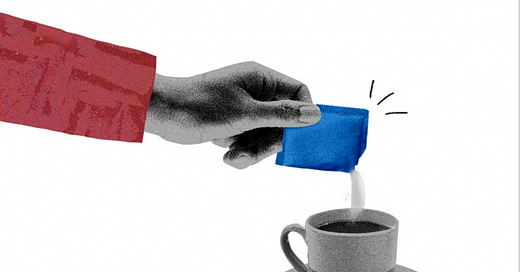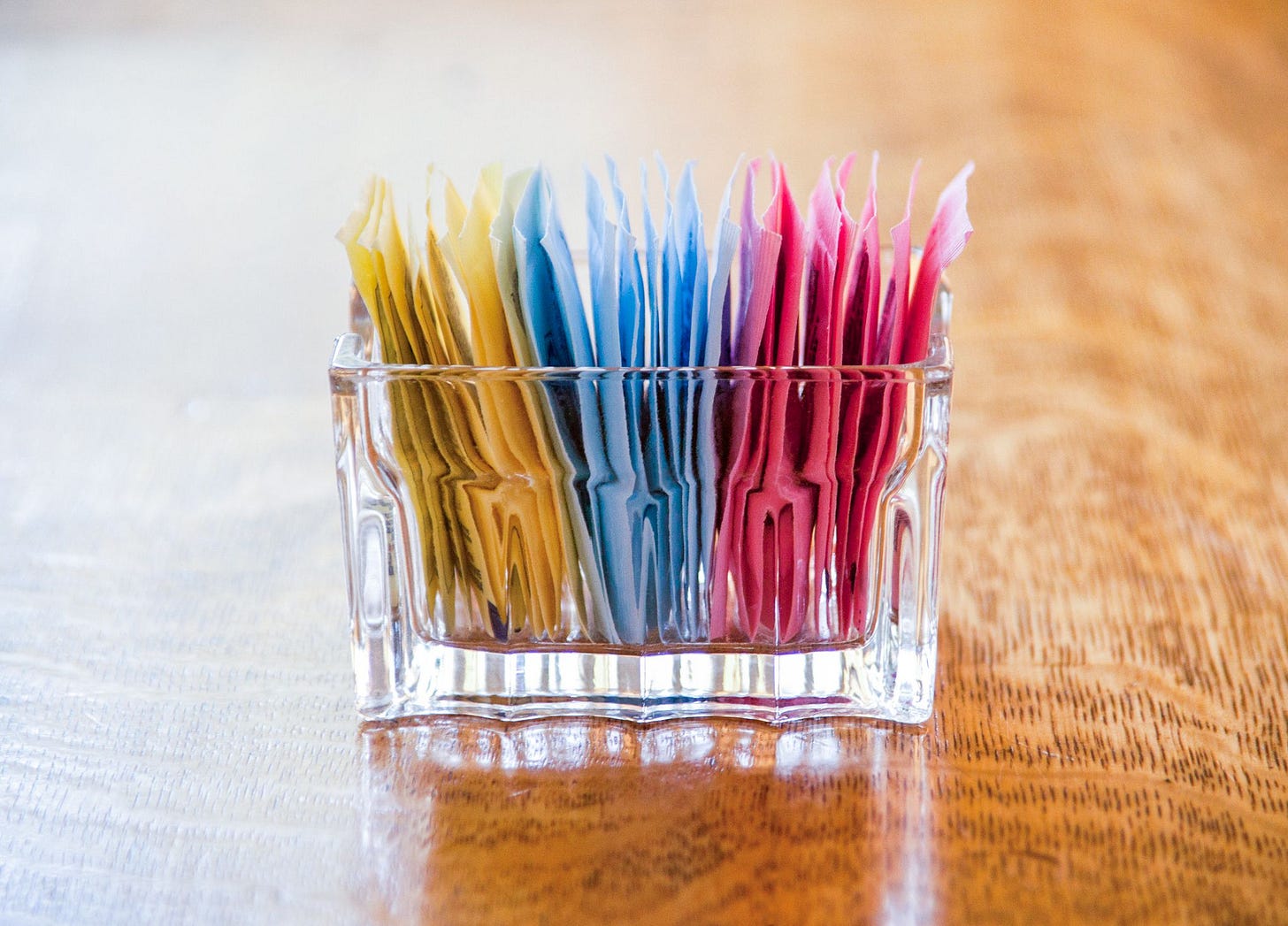Pink packet? Blue packet? Yellow packet?
The WHO's new guidelines on non-nutritive sweeteners and why the blue packet seems to be all over the media, "Aspartame, is that you?!"
You’re at your local coffee shop, you sit down at the table and order one cappuccino as you open up your laptop and take out your book. A bearded man with a dark blue apron brings you your foamy coffee, but what do you do next? To sweeten or not to sweeten? Do you choose the white, the pink, the blue, the green or the yellow packet?
“Choose your weapon, am I right?” I heard someone tell me as we both looked at the options at a Starbucks counter one day. He grabbed a couple of yellow packets, and I was left by the counter thinking, “what am I in the mood for?”
Non-nutritive sweeteners (NNS), those cute colored packets on your table, are high intensity sweeteners that are typically no-to-very low calories. Some are naturally derived from plant compounds, others are artificially made, most are hundreds of times sweeter than sugar.
Yellow: Sucralose
Blue: Aspartame
Pink: Saccharin
Sucralose is derived from sugar, making it heat-stable and useful when baking and cooking. It is poorly absorbed in the gastrointestinal tract, meaning none is broken down for energy after consumption.
Saccharin is stable at low pH and high temperatures, a reason it is found in processed foods such as juices, jams, desserts, gum, and can also be used as a tabletop sweetener.
Aspartame is one of the most common NNS used in diet beverages and is also used in other food, pharmaceutical, and personal care products (think toothpaste, breath fresheners).
There are many more, too many to go through, but a special mention goes out to Aspartame, who has been grabbing the media’s attention lately. Ah you little blue packet, small, but mighty.
FDA - Aspartame and Other Sweeteners in Food
The World Health Organization (WHO) recently released guidelines on the use of non-nutritive sweeteners. These guidelines are intended to serve as guidance, as it is actually the Joint FAO/WHO Expert Committee on Food Additives (JECFA) who is involved in assessing risk and establishing upper limits for safe consumption.
NNS consumption has been tied to a decrease in dental carries, changes in our microbiome and possible dysbiosis, long-term weight gain through proposed mechanisms of dysbiosis/alterations in sweet preference and satiety/changes in insulin response (still unclear), and to GI discomfort or the exacerbation of symptoms for people with existing conditions such as IBS/IBD.
The WHO advises against the use of NSS to control body weight or reduce the risk of noncommunicable diseases. Critics have noted that some long-term studies and randomized control trials were excluded from the guidelines that further support that NNS may have a beneficial effect on weight loss and may be a strategy for people who are looking to decrease added sugar intake. Much of the data included is also observational and conditional, all to say that for policies to be made around these guidelines, experts must take a look at specific age, use, population and country context.
The guidelines do promote “replacing free sugars in the diet with sources of naturally occurring sweetness, such as fruits, as well as minimally processed unsweetened foods and beverages.” A statement we can all get behind, after all, we know that finding balance and improving our diet quality is key.
Aspartame has now been in the limelight as the WHO is now classifying it as a 2B carcinogen. What does this mean?
The International Agency for Research on Cancer (IARC) is the specialized cancer research agency of the WHO. The IARC assesses different substances and classifies them based on how likely they are to cause cancer; keep in mind these guidelines assess hazard and not risk, where risk takes into account dose and hazard does not.
IACR Monographs Hazard Classification
In the classifications, Group 1 means there is sufficient evidence in humans and an established causal relationship to infer these things likely cause cancer i.e., smoking and exposure to solar radiation. When we go to group 2B we look at a group of things that have limited evidence in humans and insufficient evidence in animals, i.e., Aspartame, pickled veggies, and aloe vera(?)
“The dose makes the poison,” they say. The headlines can seem very scary, but these classifications do not consider the dose. Aspartame is also in a category of possibly causing cancer, so it is not probable, nor an actual carcinogen as are smoking and alcohol which are in group 1.
The newest IARC/JECFA statement “concluded that the data evaluated indicated no sufficient reason to change the previously established acceptable daily intake (ADI) of 0–40 mg/kg body weight for aspartame. The committee therefore reaffirmed that it is safe for a person to consume within this limit per day.
For example, with a can of diet soft drink containing 200 or 300 mg of aspartame, an adult weighing 70kg would need to consume more than 9–14 cans per day to exceed the acceptable daily intake, assuming no other intake from other food sources.”
And like with many things health and nutrition, in the statement they agree and acknowledge that more research is needed. Let’s not forget we are talking about an artificial sweetener, a chemical, hence why more studies are needed, because we do not know the long-term effects of these synthetic sweeteners.
Diet culture has us gravitating towards low-calorie foods and snacks, and we have to keep in mind that even though you might not drink 14 diet cokes a day, the low-calorie dessert, the sugar-free cookies, and the “light” yogurt you grab may also have Aspartame or another NNS, and that intake may add up. Make the conscious choice to enjoy the products you choose, but don’t assume that something is just “better,” because it is low-calorie/sugar-free. Like with everything else, moderation is key.
A mistake I tend to see people make when wanting to limit their sugar intake is that they replace sugar with sweeteners at a 1:1 ratio (i.e. 3 packets of sugar for 3 packets of sweetener), when in reality these are waaaay sweeter, and the portion should probably be less. As for other NNS, popular ones such as Stevia, Monkfruit, etc. more data will likely be coming up in the future *just a food for thought*.
Does this mean you have to avoid all NNS AND sugar? Nop, just be mindful, assess your diet quality and pick what works best for you.
But where does this leave us, in a climate where we claim, “all foods fit?” We have to consider that all individuals are allowed to learn and expand their knowledge on nutrition and health-related topics; eating “all foods” does not equal neglect, poor health, or a lack of boundaries. We have the freedom to make choices that align with our goals and health journeys, increase our longevity, and lead to greater satiety and satisfaction.
We must accept that a single food will not make or break our health, but it is our long-term dietary pattern that influences it, alongside MANY other factors such as our access to food, education, and healthcare.
So, if you do choose to opt for NNS I invite you to reflect, what is purpose behind this choice? How is that choice going to impact you in that moment? Do you enjoy the flavor? How much is too much for you? What would choosing another sweetener/sugar look like? What other areas of your diet can you opt for more whole foods instead?
Take a step back, think about it, consume mindfully and learn to move forward with said choice.
When you’re back at that coffee shop and that same bearded waiter brings you your coffee, do whatever brings you joy and aligns with your health journey.
Wishing you a very sweet weekend! :)
Keep on chewin’!









